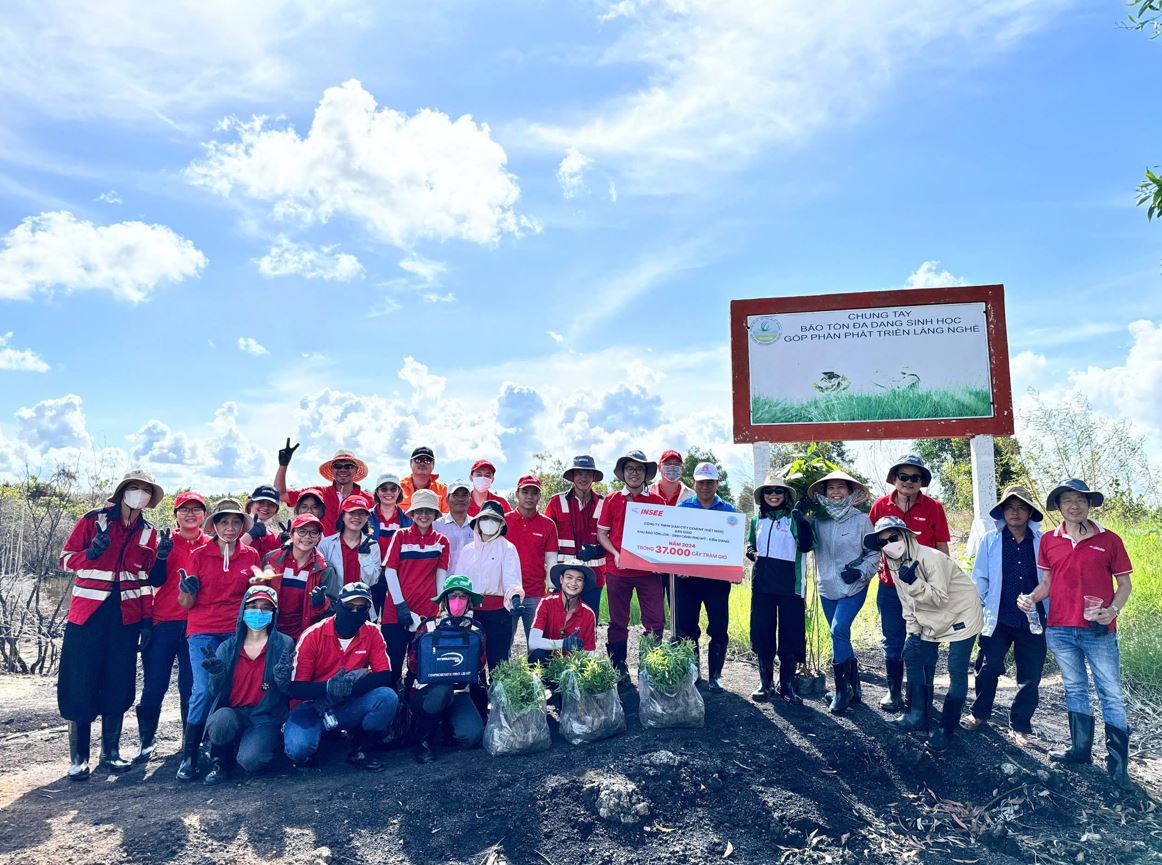Biodiversity

45 SARUS CRANES RETURN TO PHU MY SPECIES AND HABITAT CONSERVATION AREA – A POSITIVE SIGN FOR BIODIVERSITY AND SUSTAINABLE CONSERVATION IN KIEN GIANG PROVINCE
On March 16th, 2025, the management board of the Phu My Species and Habitat Conservation Area (Kien Giang Province) joyfully recorded the arrival of 23 sarus cranes foraging in the core zone of the reserve. From March 11th to 16th, a total of 45 cranes returned to the area – the highest number since the beginning of the migration season. Among them were mature individuals weighing over 10kg and standing taller than 1.3 meters, indicating a strong and vibrant flock.

Picture: Flock of 23 sarus cranes return to the core zone of Phu My Species and Habitat Conservation Area to feed, seek mates, and reproduce – Photo courtesy of Phu My Conservation Area.
Watch the clip of cranes foraging at the Phu My Species and Habitat Conservation Area: Click here.
Sarus cranes are rare birds listed in the Red Book and strictly protected in many countries. The return of large flocks to Phu My is not only a beautiful scene of nature but also a testament to the effectiveness of ongoing habitat conservation efforts in the area. According to experts, these cranes likely migrated from Cambodia to Vietnam in search of food and mates before the end of the migration season and will continue their journey to other breeding grounds. The Phu My Species and Habitat Conservation Area is one of the key ecological zones in Kien Giang province, established to protect the region’s unique wetland ecosystem and provide a natural habitat for many rare flora and fauna – including the red-headed crane. Thanks to its rich vegetation, especially sedge grasses – the cranes' main food source – Phu My is steadily asserting its role as a safe and nutritious stopover for migratory birds.

Picture: There was a time when thousands of sarus cranes lived in Tram Chim National Park – Archive photo: NGUYEN VAN HUNG.
Beyond the efforts of conservation agencies and organizations, corporate support plays a significant role in maintaining and restoring the ecological environment at Phu My. INSEE Vietnam – formerly Holcim Vietnam – a pioneer in sustainable development, has been actively contributing to conservation in the area. A cooperation agreement between Holcim and the International Crane Foundation (ICF), signed in August 2008, aimed to identify safe wetland habitats for the red-headed crane as alternatives to their former roosting grounds in the Binh Tri clay quarry and former sedge fields that had been converted into shrimp and fishponds.
From 2008 to 2016, the collaboration between Holcim/INSEE Vietnam and ICF made a strong mark through a series of biodiversity conservation and community development activities in Phu My. Beginning in 2008–2009, the two parties conducted market studies, socio-economic surveys, and vocational training programs for weaving handicrafts from Lepironia sedge to provide alternative livelihoods for local communities. These were accompanied by biodiversity conservation actions such as crane population monitoring, wetland habitat protection, and biodiversity surveys.

Picture: Sarus cranes forage in the buffer zone of Phu My Conservation Area and stay overnight – Photo courtesy of Phu My Conservation Area.
Between 2010 and 2012, the program expanded to include environmental management efforts like water level regulation, invasive weed control, wildfire prevention, and notably, support for the establishment of the Phu My Conservation Area. Holcim/INSEE’s corporate social responsibility (CSR) commitment was further reflected through practical projects such as building rainwater reservoirs for local communities and organizing annual dental checkups for students at Phu My Primary School. This nearly decade-long effort was acknowledged with a significant milestone in 2013: the official establishment of the Phu My Nature Reserve – a proud achievement in the journey of environmental conservation and sustainable development in the region. With a strong commitment to achieving a net positive impact by 2030, INSEE has implemented a series of concrete actions – most notably, the goal of planting 110,000 native trees at its plant site and two biodiversity offset areas. In 2024, over 37,000 local trees were planted and handed over to the Phu My Species and Habitat Conservation Area. In 2025, the plan will continue with the planting and handover of an additional 10,000 Melaleuca cajuputi trees – a species native to wetlands – helping to restore the natural ecosystem and support the habitat needs of species like the sarus cranes.

Picture: INSEE sponsored 37,000 native trees and organized a tree-planting activity at the Phu My Species and Habitat Conservation Area in 2024
The return of the sarus cranes to Phu My is a promising sign, highlighting the strong connection between nature and people in the effort to safeguard biodiversity. Practical actions from organizations and businesses not only help restore the environment but also reaffirm their social responsibility in sustainable development. When humans learn to live in harmony with nature, invaluable ecological treasures like the red-headed cranes will continue to thrive for generations to come.






